Abstract
Methamphetamine abuse, which surged in the early 1990s, remains a major social and health issue in recent years in Taiwan. The danger of the spread of HIV among heroin injecting drug users (IDUs) gradually increased because of needle/syringe sharing in the early 2000s. The percentage of IDUs among all addiction treatment admissions increased from 34.7% in 2000 to 63.9% in 2004, and the percentage of IDUs sharing needles increased from 4.0% in 2000 to 15% in 2004. Alerted by the escalating IDU-associated HIV situation, the Department of Health launched the national pilot harm reduction program (PHRP) in 4 of 25 cities/counties in 2005. In 2006, the Taiwan Centers for Disease Control reported a 10% decrease in all new HIV seropositive cases and a nationwide harm reduction program was implemented. Besides the implementation of PHRP, HIV testing executed in 2004 and the HIV education program were essential for the effective control of HIV. Abuse of club drugs, such as MDMA, ketamine, flunitrazepam, and zolpidem have also been a new phenomenon since the early 2000s. It is noteworthy that the ketamine-positive cases in urine samples increased sharply from 47 in 2002 to 11,616 in 2011. Although ketamine has not been scheduled by the United Nations, the epidemic level of its use and harms may have been underestimated. In summary, heroin, methamphetamine, and certain club drugs are the current major drugs of abuse in Taiwan. The risk factors of drug abuse-associated infectious diseases, such as needle/syringe sharing among heroin IDUs and unprotected sex among club drug users, deserve further scrutiny.
Keywords: heroin, methamphetamine, ketamine, Taiwan
1. Introduction
Taiwan, one of the major connecting hubs between East Asia and Southeast Asia since the Great Navigations, has encountered several substance abuse epidemics since the late 19th century. At a prevalence of 6.3% in 1900, opium smoking was the first epidemic that was gradually brought under control with the adoption of “opium licensing” and a “gradual prohibition” policy by the Japanese colonial government [1]. After World War II, the Republic of China reclaimed Taiwan, but martial law was soon imposed on the island. Between the 1950s and 1980s, a few small-scale substance abuse episodes occurred, including inhalant use (glue sniffing) in the early 1960s, the use of pentazocine in 1970s, and the use of sedatives/hypnotics (methaqualone, secobarbital, and amobarbital) in the early 1980s [2]. With the lifting of martial law in 1987, a surge of illicit heroin and methamphetamine use was observed in the early 1990s. While heroin could be managed by the Act for Eradication of Narcotics, which merely conformed to the United Nations (UN) 1961 Single Convention on Narcotic Drugs, methamphetamine, an item listed in the 1971 Convention on Psychotropic Substances, was not included in the Act [3,4]. As a result, the Act for Eradication of Narcotics was revised as the Act for Prevention and Control of Illicit Drug Hazard in May 1998 [5]. Subsequently, the Narcotics Control Act was also revised as the Controlled Drugs Act to manage addictive drugs for medical and scientific purposes in June 1999 [6].
These two new Acts control all items listed in the three UN anti-drug conventions, namely, the UN 1961 Single Convention on Narcotic Drugs, the 1971 Convention on Psychotropic Substances, and the 1988 UN Convention Against Illicit Traffic in Narcotic Drugs and Psychotropic Substances [3,4,7]. According to the Controlled Drugs Act, the Department of Health (DOH) was responsible for establishing the Substance Abuse Monitoring and Reporting System (SAMRS) to prevent and control substance abuse [1,6]. The National Bureau of Controlled Drugs (NBCD) was thereby mandated by the DOH to implement the SAMRS [6,8]. In 2010, the function of SAMRS was switched to the Taiwan Food and Drug Administration (TFDA) after the NBCD was merged as part of TFDA [1].
In this paper, based on data collected from the SAMRS, the current substance abuse and HIV situation in Taiwan is depicted from the supply and demand sides. To inform the making and management of drug policy, this study also aims to project the trends of substance abuse and HIV in Taiwan, and to analyze the risk factors of substance abuse associated infectious diseases.
2. Methods
2.1 Demographic Description
The demographic information was obtained from the Ministry of Interior, Executive Yuan, Taiwan [9].
2.2 Data collection
Substance abuse data representing both the supply and demand sides were obtained from the Substance Abuse Monitoring and Reporting Systems (SAMRS), which was maintained on a monthly basis by the NBCD (before December 31, 2009) and the TFDA (after January 1, 2010) of the Department of Health, Taiwan. The SAMRS, composed of 5 subsystems [1], is briefly described below:
-
2.2.1
Data collection subsystem on arrests and drug seizures (SADS): The data, collected monthly, were from the Investigation Bureau, Ministry of Justice; the National Police Administration, Ministry of Interior; and the Headquarters of Military Police, Ministry of Defense. In this study, the time frame was from January 1999 through December 2012.
-
2.2.2
Data collection subsystem on laboratory drug testing of urine (LDTU) for court referrals: The data, collected monthly from January 1999 through December 2012, were from the Investigation Bureau, Ministry of Justice; the National Police Administration, Ministry of Interior; the Headquarters of Military Police, Ministry of Defense; the Department of Health; and all local health departments.
-
2.2.3
Reporting subsystem for addiction treatment (RSAT): Data were collected from the DOH-designated psychiatric hospitals for addiction treatment from January 1999 through December 2012. In this subsystem, cases of substance abuse were reported online.
-
2.2.4
Reporting subsystem of HIV/AIDS (RSHA) from the Center for Disease Control, Department of Health, Taiwan, from December 1984 through December 2012.
-
2.2.5
National Household Survey (NHS): The survey was first conducted by the NBCD in 2005, and subsequently in 2010.
2.3 Data analysis
The indicators of substance abuse on the demand and supply sides included: arrestees and seizures of drugs (from the SADS system), positive cases of urine samples (from LDTU system), the prevalence of illicit substance abuse (from NHS), the reported cases for addiction treatment and administration routes (from RSAT), and reported cases of HIV/AIDS and HIV infection ratios by exposure category (from RSHA).
3. Results and Discussion
3.1 Demographic description
With a total land area of 36,000 square kilometers (14,000 square miles), Taiwan is densely populated with 23,315,822 persons (as of December 2012) [9]. The GDP per capita nominal in 2011 was US $21,900, ranking 39th in the world [10]. The Purchasing Power Parity (PPP) was $38,200, ranking 28th globally (2011 IMF estimate) [11]. In other words, while the economy of Taiwan has substantially improved in the past three decades, the high population density (648 persons/km2 land area) has made life on this island country very competitive.
3.2 Prevalence of illicit substance abuse
The prevalence of illicit substance abuse was 1.2% in 2005, according to the first National Household Survey. The top five most popular illicit drugs were methamphetamine, MDMA, ketamine, cannabis, and heroin. Regarding the location of first-time drug use, methamphetamine was mostly used at home, whereas MDMA and ketamine were used in clubs or KTVs (karaoke TV bars). The rates of poly-drug users among all illicit substance abusers were 32.5% in the 18 to 64-year old group and 50% in the 12 to 17-year-old group; 2.1% shared needles in the 18 to 64-year-old group, but none shared needles in the 12 to 17-year-old group.
The prevalence of illicit substance abuse was 1.4% in 2009, according to the second National Household Survey. The top five most popular illicit drugs were methamphetamine, ketamine, MDMA, cannabis, and heroin. The places where illicit drugs were first used were homes and clubs. The estimated number of illicit substance users among 12- to 64-year-olds was 204,846 in 2005 and 252,054 in 2009.
3.3 HIV infection among injecting drug users (IDUs)
The percentage of IDUs among all addiction treatment admissions increased from 34.7% in 2000 to 63.9% in 2004. The percentage of IDUs sharing needles increased from 4.0% in 2000 to 15% in 2004 [12]. Alerted by the escalating IDU-associated HIV situation, the DOH launched the national pilot harm reduction program (PHRP) in 4 of 25 cities/counties in 2005. In 2006, Taiwan CDC reported a 10% decrease in all new HIV-seropositive cases, and so a nationwide harm reduction program was implemented. Besides the implementation of PHRP, HIV testing instituted in 2004 and the HIV education program were also essential for the effective control of HIV [12].
Although the HIV incidents due to heroin IDUs have been alleviated to some extent, recent results indicate that male homosexuality was a major risk factor associated with HIV infection. As shown in Figure 1, according to the cumulative cases of HIV infection by exposure category in Taiwan, the main risk factors were male homosexuality (41.9%), IDUs (27.6%), and heterosexuality (20.3%), respectively. These results imply that while the spread of HIV through needle/syringe sharing among IDUs may be manageable, measures to curb HIV spread via unprotected sex, especially under the influence of drugs, should be taken without delay.
Fig 1.
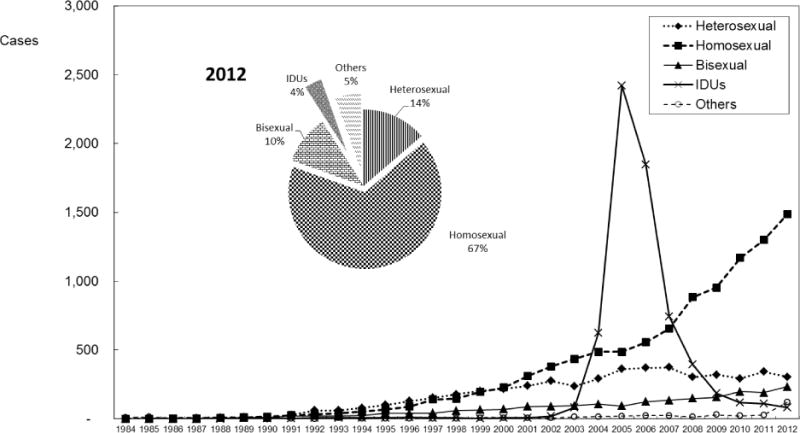
Cases and ratios of HIV infection by exposure category in Taiwan from 1984 through 2012.
3.4 Current substance abuse status
To learn the current substance abuse status from the supply side, the amounts of major drug seizures in Taiwan from 1999 through 2012 were collected and analyzed (Figure 2). Based on the amounts of drug seizures, ketamine, heroin, and methamphetamine were the main abused drugs. It is also noteworthy that the amounts of ketamine seizures increased sharply in recent years. Taking the demand side into consideration, the results of the drug mentions among treatment admissions from hospitals in Taiwan (Figure 3), laboratory testing on the urine collected from drug offenders in Taiwan (Figure 4), and drug users sentenced to prisons (Figures 5 and 6) also indicated heroin, methamphetamine, and ketamine as being the major drug problems. The current substance abuse status is further explained as follows.
Fig 2.
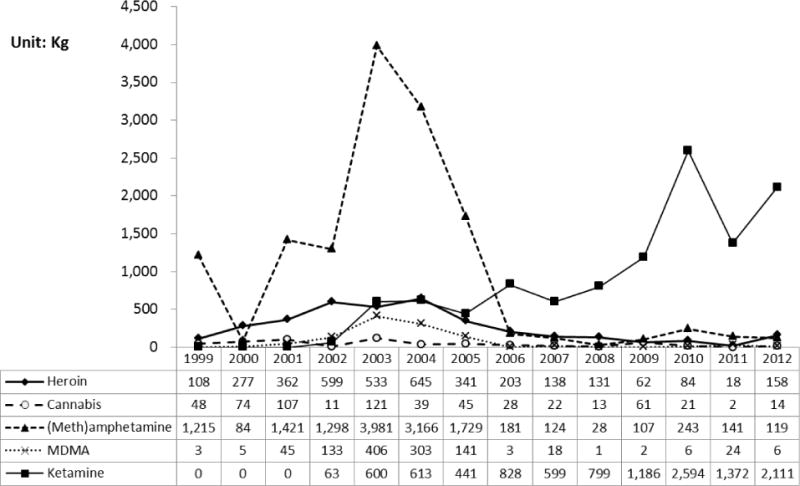
Amounts of drug seizures in Taiwan from 1999 through 2012
Fig 3.
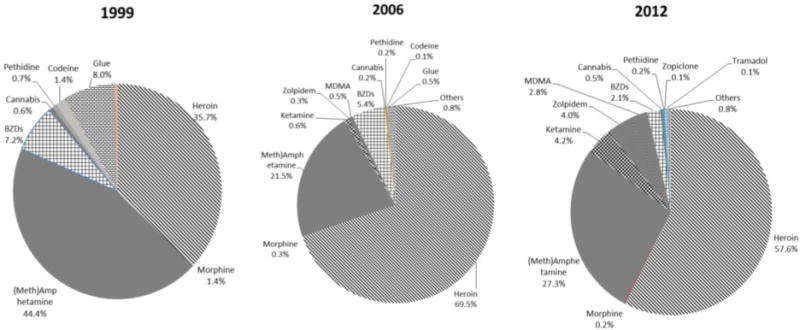
Drug Mentions among Treatment Admissions from Hospitals in Taiwan from 1999 through 2012
Fig 4.
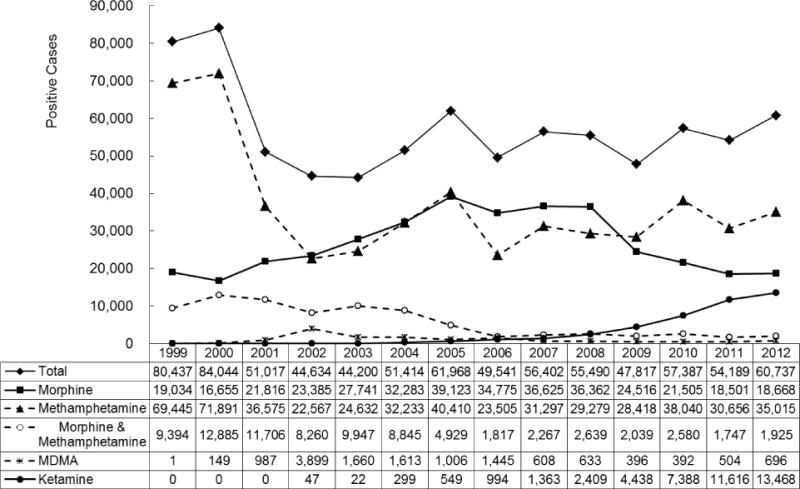
Results of Laboratory Testing on the Urines Collected from Drug Offenders in Taiwan from 1999 through 2012
Fig 5.
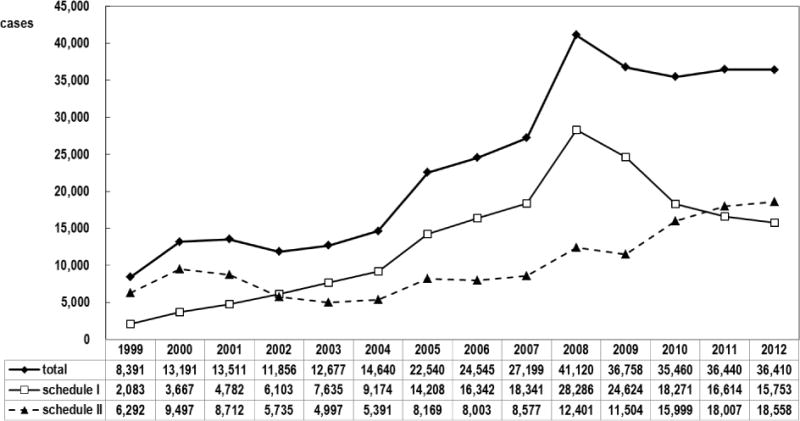
Number of schedule I & II drug offenders sentenced to prisons in Taiwan from 1999 through 2012. Heroin and methamphetamine were the most commonly abused schedule I and II drugs, respectively.
Fig 6.
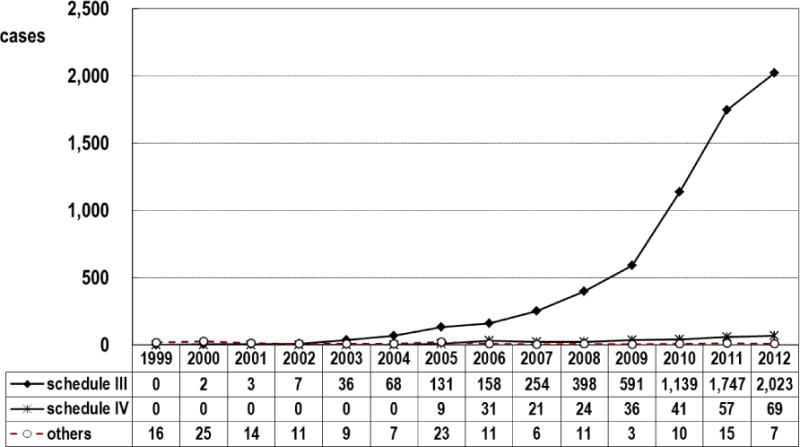
Number of schedule III & IV offenders in jails in Taiwan from 1999 through 2012. Most schedule III drug offenses were charged against illicit ketamine manufacture or misconduct.
3.4.1 Methamphetamine and heroin
From 1999 through 2012, methamphetamine and heroin have been the two major drugs of abuse. Spread of HIV/AIDS by needle sharing among heroin IDUs has become a public health concern. The harm reduction policy has been in place since 2005.
The rate of heroin abusers among treatment admissions was 35.7% in 1999. The rate increased to 69.5% in 2006 and decreased to 57.6% in 2012. Methamphetamine was the most abused drug before 1999, but its use somewhat stabilized after 2006 and now it is ranked second after heroin.
3.4.2 Ketamine
It is noteworthy that the ketamine-positive cases in urine samples increased sharply from 47 in 2002 to 13,468 in 2012 [13]. The amount of ketamine seized also increased sharply from 63 kg in 2002 to 2,111 kg in 2012 [13]. Most ketamine abusers have been young (under 27 years old). The harms caused by ketamine, including dependence, cognitive impairment, emergence phenomenon, and interstitial cystitis, may be greater than expected [14,15]. The surge in both the supply and demand sides indicate that ketamine abuse should be closely monitored. Although ketamine has not been scheduled by the United Nations, the epidemic level of its use and harms may have been underestimated.
3.4.3 Benzodiazepines and “Z” drugs
Prescription drug abuse was also a major concern during the 2000s. The abuse of benzodiazepines increased steadily and “Z” drugs (zolpidem and zopiclone) have become epidemic since the mid-2000s. Most of them were schedule III or IV drugs; therefore, the users of these illicit drugs were not indicted.
3.4.4 Emerging new drugs
The seizures of marijuana and cocaine were relatively small. However, the abuse of some synthetic cannabinoids [e.g., JWH-250(K2) JWH-018(K2)] and cathinones [e.g., mephedrone, MDPV (Methylenedioxypyrovalerone)] have been a new concern. In addition, Salvia divinorum is available from the Internet.
4. Conclusion
Heroin, methamphetamine, and certain club drugs are currently the major drugs of abuse in Taiwan. Although ketamine has not been scheduled by the United Nations, the epidemic level of its use and harms may have been underestimated. The risk factors of substance abuse associated infectious diseases, such as needle/syringe sharing among heroin IDUs and unprotected sex among club drug users, deserve further scrutiny. New drugs such as Salvia divinorum, synthetic cannabinoids, and cathinones, may pose a new threat to our health, and therefore preventive measures are advised.
Acknowledgments
This work was supported in part by the Food and Drug Administration, Department of Health, Taiwan (DOH102-FDA-61102).
References
- 1.Li JH. Evolution of the legislative and administrative system of controlled drugs in Taiwan. J Food Drug Anal. 2012;20:778–785. [Google Scholar]
- 2.Li JH, Liu SF, Yu WJ. Patterns and trends of drug abuse in Taiwan: a brief history and report from 2000 through 2004. Epidemiologic trends in drug abuse; Proceedings of the Community Epidemiology Work Group; 2005 June; Denver, CO. Bethesda, MD, U.S.A: National Institute on Drug Abuse, National Institutes of Health, Department of Health and Human Services; 2006. [Google Scholar]
- 3.United Nations. Single Convention on Narcotic Drugs. United Nations; 1961. [Google Scholar]
- 4.United Nations. Convention on Psychotropic Substances. United Nations; 1971. [Google Scholar]
- 5.Presidential Gazette, Taiwan, R.O.C. No. 8700099860. Law for Prevention and Control of Illicit Drug Hazard. May 20, 1998. [Google Scholar]
- 6.Presidential Gazette, Taiwan, R.O.C. No. 8800124380. Controlled Drugs Act. Jun 2, 1999. [Google Scholar]
- 7.United Nations. Convention Against Illicit Traffic in Narcotic Drugs and Psychotropic Substances. United Nations; 1988. [Google Scholar]
- 8.Presidential Gazette, Taiwan, R.O.C. No. 8800124390. Act for the Organization of National Bureau of Controlled Drugs. Jun 2, 1999. [Google Scholar]
- 9.National Census and Demographic Statistics. Ministry of the Interior, Taiwan; Available at: http://sowf.moi.gov.tw/stat/month/elist.htm. Accessed April 12, 2013. [Google Scholar]
- 10.List of countries by GDP (nominal) per capita. CIA world factbook. Available at: http://en.wikipedia.org/wiki/List_of_countries_by_GDP_(nominal)_per_capita. Accessed June 14, 2013.
- 11.GDP – per capita (PPP) CIA world factbook. Available at: http://www.indexmundi.com/g/r.aspx?c=tw&v=67. Accessed April 12, 2013.
- 12.Lee HY, Yang YH, Yu WJ, et al. Essentiality of HIV testing and education for effective HIV control in the national pilot harm reduction program: the Taiwan experience. Kaohsiung J Med Sci. 2012;28:79–85. doi: 10.1016/j.kjms.2011.10.006. [DOI] [PubMed] [Google Scholar]
- 13.Food and Drug Administration, Department of Health, Executive Yuan. Statistics of drug abuse in Taiwan [Updated 2013 Feb] Available from: http://www.fda.gov.tw/TC/site.aspx?sid=3429. Accessed April 12, 2013.
- 14.Li JH, Vicknasingam B, Cheung YW, et al. To use or not to use: an update on licit and illicit ketamine use. Subst Abuse Rehabil. 2011;2:11–20. doi: 10.2147/SAR.S15458. [DOI] [PMC free article] [PubMed] [Google Scholar]
- 15.Nutt D, King LA, Saulsbury W, et al. Development of a rational scale to assess the harm of drugs of potential misuse. Lancet. 2007;369:1047–1053. doi: 10.1016/S0140-6736(07)60464-4. [DOI] [PubMed] [Google Scholar]


